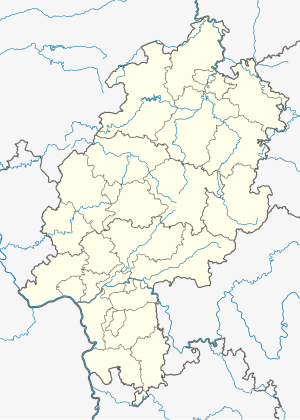Animal and plant park Fasanerie
| Animal and plant park Fasanerie | ||
|---|---|---|
| Full name | Animal & Plant Park Fasanerie | |
| motto | Meeting point nature | |
| place | Wilfried-Ries-Strasse 22 65195 Wiesbaden |
|
| surface | 23 hectares | |
| opening | March 31, 1955 | |
| Animal species | about 50 species | |
| Individuals | approx. 250 animals | |
| Species focus | European animal species | |
| organization | ||
| Sponsorship | State capital Wiesbaden | |
| Funding organizations | Förderverein Fasanerie e. V. | |
|
The hunting lodge with the main entrance to the right |
||
| Animal & Plant Park Fasanerie | ||
|
|
||
Coordinates: 50 ° 6 ′ 9 ″ N , 8 ° 11 ′ 32 ″ E
The zoo and plant park Fasanerie is operated by the state capital Wiesbaden and is located outside the city in the northwest in the Wiesbaden city forest on an extensive area of around 23 hectares .
The landscape is very varied with hills, meadows, a high proportion of forest, streams and a lake. The buildings of an estate and the hunting lodge are under monument protection. In the vicinity is the former summer resort on the Chausseehaus , the Kaiser Wilhelm Tower on the Schläferskopf and the former Klarenthal Abbey .
history
The pheasantry has its origins in a pheasant farm founded by Prince Karl von Nassau-Usingen around 1750 . The princely court architect, Friedrich Joachim Stengel, designed the plans for the Baroque Fasanerie hunting lodge, which was built from 1744 to 1749. After Karl's death in 1775, his successor Karl Wilhelm moved his hunting ground to the Platte and dissolved the pheasantry. The small castle was then used as the head forester's apartment until the property became the property of the city of Wiesbaden on July 1, 1912.
Today's zoo and plant park was opened on March 31, 1955 by the city of Wiesbaden. In 1995 the Förderverein Fasanerie was founded in order to rehabilitate the site, which was in poor condition . The aim of the association is to promote the zoo and plant park with the help of donations without having to charge entry fees. The hunting lodge now serves as a restaurant.
Animal and plant population
The pheasantry houses over 250 animals, which are divided into around 50 different animal species, which are used to the local climatic conditions, including brown bears and wolves , which live together in a large, natural enclosure . In addition to a children's petting zoo following animals are located in the park: fallow deer , otters , domestic sheep , domestic pig , pheasant , golden pheasant , peacock , lynx , raccoon dog , nutria , red fox , red deer , barn owl , mallard , Stork , raccoon , wild cat , wild boar , bison and Goat .
The nature park has rare and exotic plants such as one of the thickest sequoia trees in Germany as well as some old specimens of mountain ash , yew , ginkgo , robinia , horse chestnut , red beech , red oak , Spanish fir , holly , pedunculate oak and sessile oak .
Events
A whole series of natural history tours are organized throughout the year, primarily for children and young people. Interesting facts about animal and plant species are conveyed in a lifelike environment.
The organizers for these tours are the Förderverein Fasanerie and the Nature Education Center .
Projects
In the nature workshop , children and young people are given the opportunity to get to know animals and nature creatively in a playful way.
Picture gallery
Web links
Individual evidence
- ^ History of the pheasantry. wiesbaden.de, accessed on June 25, 2013
- ↑ Mammoth trees in Germany - DE-ID41. Sequoia Community, August 21, 2006, accessed August 9, 2009 .










